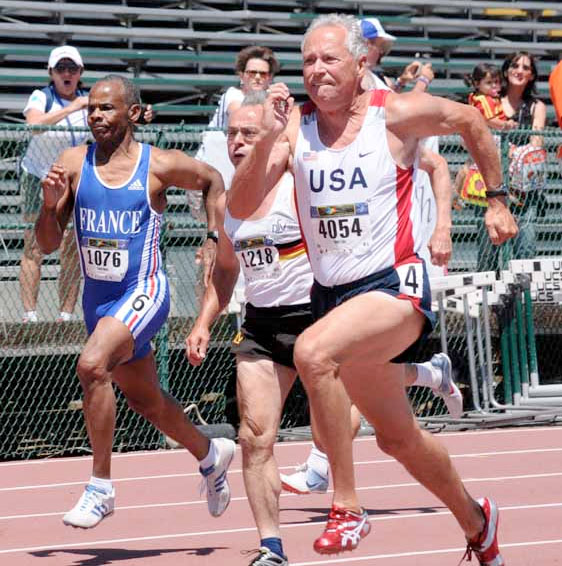Now you can feel superior to kiddie nonathletes besides own demo

Bob Lida may be the recordman cited in cell study.
Here’s the summary for posterity:
Elite runners do not experience the muscle weakening associated with aging as non-athletes do. A new study published in American Journal of Physiology—Cell Physiology examines if their superb fitness is because their muscles have not aged.
Movement and strength come from the muscle fibers that make up a muscle group contracting and generating tension. Muscle weakening happens when the fibers contract slower and with less force. A team of Canadian researchers hypothesized that the constant physical training of older elite runners preserved their muscle fibers such that the fibers behaved like those of young adults.
Muscle fiber samples were taken from the quadriceps of older elite runners and non-athlete adults in the same age range. “One of the most unique and novel aspects of this study are the exceptional participants,” says lead author Geoff Power of University of Guelph in Canada. “These are individuals in their 80s and 90s who actively compete in the world masters track and field championships. In the study, we had seven world champions, and everyone placed in the top four of their respective events.”
The fibers’ contraction speed and force were compared to fibers from 23-year-old non-athlete adults. Muscle fibers from older non-athletes contracted considerably slower and weaker than fibers from young non-athletes. To the researchers’ surprise, the muscle fibers of masters athletes contracted at a speed and force similar to those of older non-athlete adults, not the young adults. Success in high-performance sports in old age does not appear to be due to maintained contraction capability of the fibers, Power says.
This study suggests that aging is associated with decreased muscle quality regardless of physical activity status, according to Power. However, other studies have shown that muscle fibers can be arranged in a variety of ways to optimize strength, speed and power of the whole muscle, Power says, so there are many structural ways to compensate for the reduced performance at the fiber level to maintain performance at the whole muscle level.
Researchers from McGill University, University of Calgary and University of Quebec at Montreal were also involved in the study. The article “Reduction in single muscle fiber rate of force development with aging is not attenuated in world class older masters athletes” is published ahead of print in American Journal of Physiology—Cell Physiology.





7 Responses
The article and study say attenuation is NOT reduced. Something else is going on to compensate compared to non-athletes. They go over some guesses in their conclusions.
” To the researchers’ surprise, the muscle fibers of masters athletes contracted at a speed and force similar to those of older non-athlete adults”
That’s strange.
So the “samples” used come from a maximum of about five athletes? I don’t doubt there is some truth in the findings, but that’s hardly the most representative sample group.
There were 20 masters athletes in the study. All over 75. I was recruited in Finland, at the Indoor World Championship.
Given how long it takes to get peer reviewed articles published in journals, the sampling would have had to take place well before Lyon – several years before is my guess.
The tests were actually done in Montreal in the fall of 2012 and included 10 female masters athletes over 75.
The whole series took one week at McGill University
What study supports this summary’s opening statement? “Elite runners do not experience the muscle weakening associated with aging as non-athletes do.”
Leave a Reply